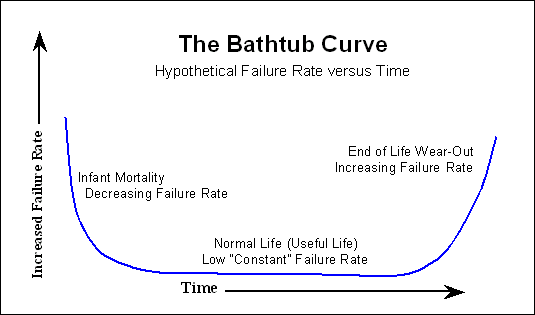It is not uncommon to hear people talking about MTBF for a product ….. and immediately discover that they really mean life time ! Indeed, the recent articles about “planned obsolescence” offered a lot of opportunities to hear concept like MTBF, MTTF, etc ..
To be fair, MTBF is very badly named and this can easily lead to confusion. On top of that, all this Reliability and Product Quality in general is not (or not often) taught in undergraduate cursus.
So let’s start by a couple of definitions and concepts:
MTBF = Mean Time Between Failure . The thing is, MTBF has nothing to do with time ! For example, a hard disk mechanism MTBF is typically between 300,000 and 1,200,000 hours. Depending on how much time you use your hard disk each day, this amounts to at least 100 year ! Can you believe that only one second ?
On the other hand, Product lifetime, as the name suggests, is the expected period of time where your product is usable. So, say a product lifetime is 5000 hrs (about 2.5 years, considering average usage) that probably means that MTBF shall be about (exactly ?) the same duration, otherwise it does not make sense. Well, a typical PC has a MTBF of 5000 hrs … and each other experience shows that the product last much longer than that, generally.
OK, so what’s wrong here ?
Let’s start with the famous Bathtub curve, which depicts a typical product life, and is widely used in all the Quality and Reliability litterature

The product life starts off by an “infancy” period, during which a lot of failures happen, for a lot of reasons (bad assembly, materials defects, …). This is not desirable and any decent manufacturer use various techniques to “skip” these defects before the product is shipped (burn-in, stress testing, temperature testing, ..). So when you buy a product, that should be AFTER this undesirable infancy period.
Then we have a “Useful Life” period … these are the 5000 hrs of our PC above. Following that is the “End-Of-Life” period we all know about. It is very common to hear that, for cars, after a period of time, a lot of things break together or frequently.
During the Useful Life of a product, we can measure the failure rate. This is a statistical measure observed over a large (ideally infinite) number of products. The slope of this curve IS the MTBF, so expressed mathematically in hours .. hence the confusion. From this, it is easy to understand why MTBF has NOTHING TO DO with lifetime, strictly speaking. It is just an attribute of the product which, to some extent, gives an idea of its “quality”.
Let’s take a small example (free translation from www.apc.com)
Take a population of 500 000 people aged 25 and collect the number of defects over one year. Here, by defect, we consider an Human ceasing to “operate” 🙁 . After one year, we have 625 deaths among this population.
The “failure rate” is then 625 / 500 000 = 0.125% per year. The MTBF is the inverse of the failure rate, which is … 800 years ! We are back to Mathusalem times 🙂
